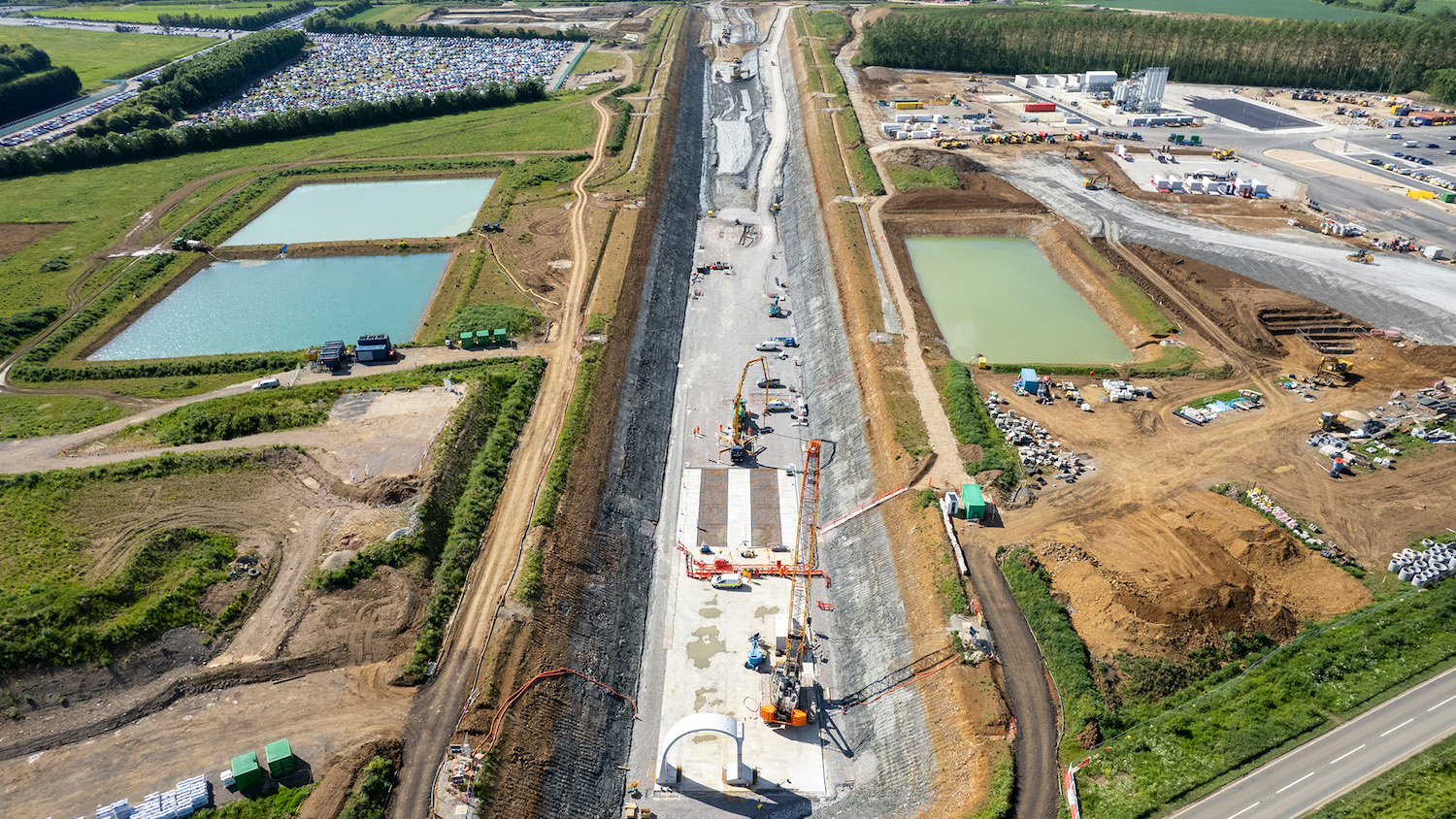
Laminar Projects’ approach to digital transformation for the Eiffage, Kier, Ferrovial and BAM Nuttall joint venture (EKFB) working on HS2 Phase 1 was a compelling winner of the Best Use of Data on a Project at the Digital Construction Awards 2023. We speak to the Laminar team to find out more about their work and what happens next.
Laminar Projects’ journey towards HS2 began in 2016 when the business was founded to help construction harness digital processes and data to improve planning and performance. In just seven years, it has grown from a start-up of two to 150 people.
“So we’re not a small start-up anymore, but we have the start-up mindset,” says Lampros Arvanitis, associate director in the data and digital team.
“We’re flexible in the way we work, and in general we’re people who have all worked on construction sites. We all have a passion for improving construction through digital ways of working.”

“Huge teams are created just to process data from one system to another. But the technology exists to create better solutions.”
The firm is effectively split into two: the consultancy team, and the product team. The consultancy team itself is split into three disciplines:
- planning and project controls;
- data and digital, where Arvanitis and his colleague Will Needham work; and
- project management.
The other side of the business is focused on developing software-as-a-service, and most of Laminar’s earnings are going into product development of Shape – a series of apps for construction management.
Data and confusion
Needham, lead data strategist, says that the key to Laminar’s success is that it can leverage the learnings from other industries, in terms of data engineering, data analytics and data warehousing, and can make sure that projects and clients in the construction industry are digitally transformed with a data-first approach and combine this with a deep understanding of construction.
Needham says: “The problem that we solve quite well is on a complex construction project, especially a very big one where there’s a lot of people, a lot of confusion – and a lot of data. And as projects get bigger, so does the amount of confusion, and the amount of data that’s being created and managed and transferred, between hundreds of different companies – and it becomes very complex.
CVs
Arvanitis comes from a BIM and information management background, and Needham from a data science and construction management background.
Arvanitis says: “I have a masters in civil engineering. I quickly realised that I am very drawn to the digital space in construction. I came to the UK from Greece and did an MSc in Building Information Modelling at the University of the West of England in Bristol. And then I started working in BIM roles for tier 1 contractors – BIM technician, to BIM coordinator, to BIM manager and BIM lead.
“I joined Laminar two years ago. Before that, I worked for Costain for four years. I was able to learn, hands on, how BIM and other digital technologies and systems are being implemented in projects, and what the challenges are in terms of data silos there.
“This is when I became more interested in data, in how we can centralise data from different systems. So I joined Laminar with this vision and purpose, to achieve that.”
Needham says: “I studied for a degree in architectural engineering and design management at Loughborough University. As soon as I left, I spent a couple of years in BIM and digital engineering for Skanska and Mott MacDonald.
“Then I got more and more involved in data, and the technical side of things. I learnt programming with Python, and did a master’s degree in data science. Around the same time, I also got chartered, so I am a chartered construction manager.
“Then, for the past four or five years, I have been working in data science roles, and currently data strategy for construction and engineering projects.”
“Projects of the scale of HS2, which is the project we won our award for, require a different way of thinking about how we manage all this information. Because there is too much to handle manually. A person can’t manage and understand the thousands and thousands of data points and document files.”
Centralising information
He continues: “So our USP for this project has been to develop a solution that centralises information and data from about 10 project systems into one place, so that we can make sense of it. And then we create dashboards and reports for people to get instant access to up-to-date data for improved decision-making and process visibility. That is difficult to do normally, because you’ve got lots of different systems and everything is in these different silos.
“We’re not really about the software per se. We care more about the construction processes and the associated data being generated. And that’s something that’s generally missing from the industry. There’s a big focus on software, but not necessarily understanding of how construction projects work.”
The pair say that so often on construction projects, companies buy more and more software packages, all of which then collect data and then constantly have to manually export data from one system, process it somewhere else, and then upload it onto another system.
Arvanitis adds: “This is a major problem on construction projects. Huge teams are created just to process data from one system to another. But the technology exists to create better solutions, where the data is processed and transferred automatically, with huge time savings.”
Building the data warehouse
Laminar Projects built a centralised data warehouse for the EKFB JV on HS2 in Microsoft’s cloud platform Azure to bring data together and then develop processes to turn it all into the same inter-operable format. The system in this project and more generally is created for the client who then owns it and can use it on other projects.
Needham says that although there has been talk for some time now of harnessing data to improve construction, it feels like the moment has now definitely arrived. “It is the natural evolution of the industry, from the original BIM mandate, to now ISO 19650, and the push for data information management. This is where our aim is. But we are making it clear that we’re not only talking about design information, or only information coming from the construction sites. We’re interested in the wider information and data management for a project.”
Arvanitis adds: “There is a big gap in terms of how commercial data is being managed – HR data, environmental data, etc. We need to look more holistically at all the data that is being generated and captured in the construction industry.”
Working on HS2

“Projects of the scale of HS2, which is the project we won our award for, require a different way of thinking about how we manage all this information. Because there is too much to handle manually.”
Laminar Projects is working for the information management team within the EKFB JV on HS2. Their work began three years ago on the Phase 1. The section EKFB is building – constructing 80km of rail and more than 4,000 primary assets in the middle section of the line up to Birmingham – is worth £2.3bn alone. “The information generated is too much, the document deliverables alone are more than 150,000. And asset data in general, it is many millions,” Arvanitis explains.
“So the idea is that the information management team set up several systems to manage information. They had a document management system since the beginning of the project, BIMXtra. They have CAD management systems, both BIM 360 and ProjectWise, and they also have an asset management system.
“And they also need to transfer information to the HS2 systems. HS2 has a different document management system, a different asset management system. There are three systems from the contractor and three systems from the client, and these systems weren’t talking to each other. The project was struggling to find the latest information, to report on the latest information.”
Implementing Azure
He continues: “One of the first things we did was to implement an Azure data warehouse, bringing all the data from these different systems into one place, and then start developing reports on top of that.
“We believe that any digital transformation needs to focus on processes first: so you need to map the processes, understand the processes, and then improve them through digital ways of working.”
The EKFB team can generate reports themselves, but they often call on Laminar Projects’ expertise in building powerful data presentations and extracting useful data to help solve problems on HS2. “The client will come to us and say ‘we are really struggling with this process, it is causing us delays, no one really knows what is going on. Please can you do an investigation, and use the data in the warehouse to create a report to help us shine a light on this process that is causing us so much bother’.”
Arvanitis adds: “We’ve built a lot of reporting for these big pain points on the project. And that continues today.”
Design assurance
Benefits for EKFB
Time saved through automation of data collection, report generation and improved key data access is estimated to provide project savings of 85 FTEs, or £10.3m a year.
The data warehouse has grown significantly from three to 26 tables and increased data stored by a factor of 8.5. This provides the project with a single source of truth across six project systems spanning three organisations.
A single source of truth for data enables identification of inconsistencies and data errors. This has increased trust and improved collaboration between teams, improving coordination and providing a holistic project understanding to management. This is estimated to save 209 hours per week of people’s time looking for the information they need.
Timeliness of information due to continuous collection: the cost of this would be prohibitively expensive at £49m a year to achieve the same outcomes across 31 data transformations and 11 reports containing 50 pages. This up-to-date information is crucial in helping EKFB and its supply chain improve design coordination and identify process bottlenecks.
Needham says that one example is in design assurance. “Each piece of design on a project needs to be checked by people, to make sure it’s fit for purpose and buildable. At this scale, it’s a very difficult task: it’s a project within a project, managing all these different information deliverables that need to be approved and signed off by various people and teams and the client. And all those different touchpoints happen in different systems. So it becomes a complex process, which makes it difficult to manage.”
He continues: “We created a report that allows them to track the design and the priority packages that need to be signed off. And in each of those packages, you have these 100 drawings. [The drawings are at different stages]: ‘This one is still being signed off by this person, this one hasn’t even been started yet, so you need to start that quickly. This one, we sent to the client and they rejected it.’
“We put all the information in one place for them to review, so they can understand which work packages are ok. So they can say: ‘This work package looks good, this work package is the one that we really need to focus on, because we need to get it over the line in the next few weeks, but at the moment we’re a long way away from that.’”
Needham adds that Laminar Projects has also built summary reports on top of the data for senior leadership to provide a general picture of progress on HS2, as opposed to the nitty gritty details.
Cost savings
The time saving from being able to find information quickly and produce reports like this has saved the EKFB JV contractor £10.3m a year, according to Arvanitis. “If they had to do all this stuff manually, they would need approximately 85 more people in the project.”
In terms of rolling out to other teams in HS2, he adds: “All these different JVs are working almost independently. So it is difficult to implement solutions across the project. But we are sharing our learnings with our client, with HS2, and they are taking them on board. And we are helping other smaller clients get on the journey as well.”
Don’t miss out on BIM and digital construction news: sign up to receive the BIMplus newsletter.












